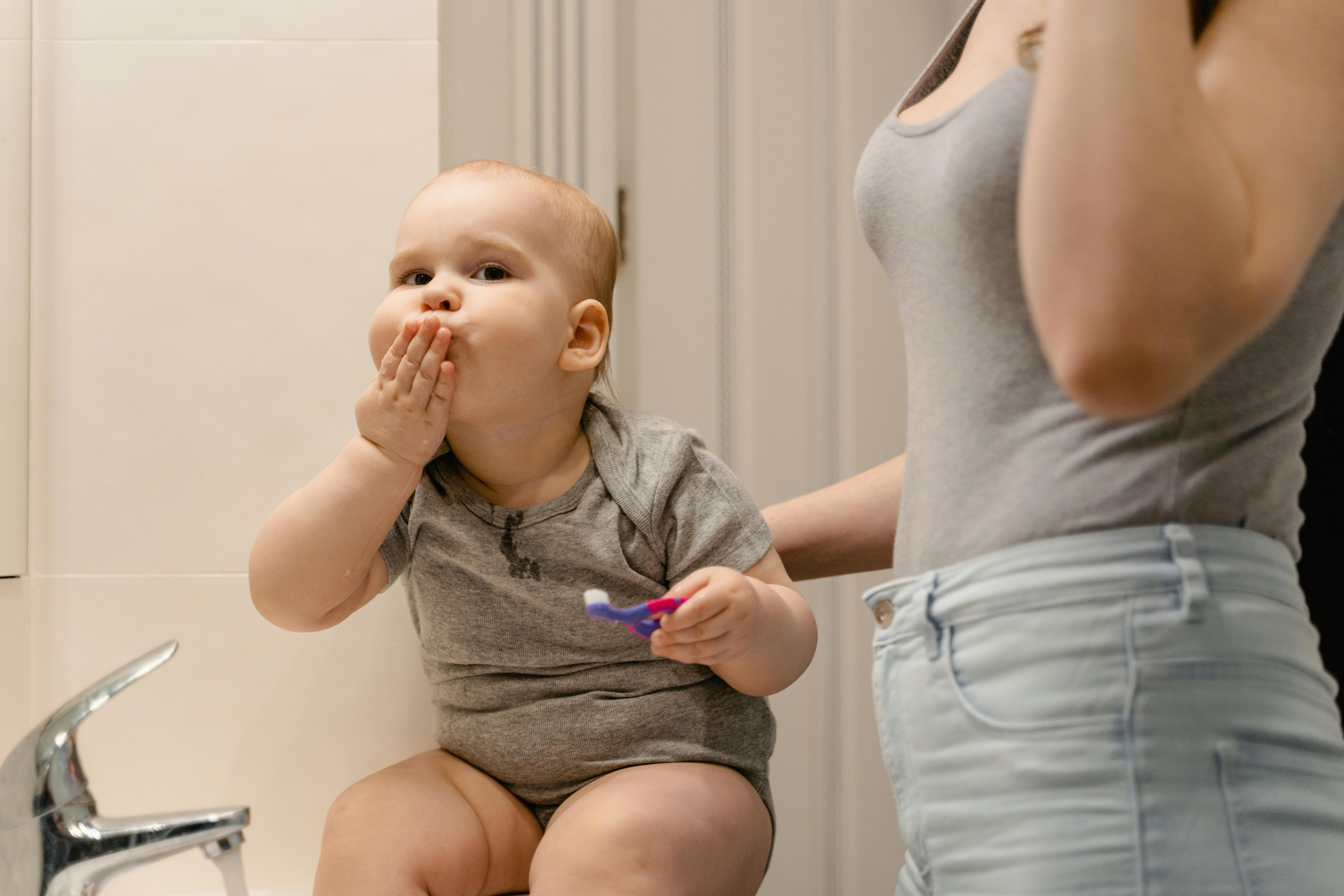A binky, also known as a pacifier, is a popular tool used to soothe babies. It can be difficult to keep in a baby’s mouth, however, as they tend to spit it out or drop it. This article will provide helpful tips on how to keep a binky in a baby’s mouth so you can ensure your little one stays content and happy.To keep a binky in a baby’s mouth, make sure the baby is in a comfortable position. Gently put the binky in the baby’s mouth and hold it there for a few seconds until the baby starts to suck on it. If the baby begins to cry, move the binky around or try different angles until you find one that works. Once the baby is sucking on the binky, gently let go and allow them to continue sucking.
Reasons Why Babies Need a Binky
Babies find comfort in sucking, and a binky can fulfill this need. It can also be used as a way to calm a cranky baby. A binky can also help relieve pressure in the ears while flying or when the baby is teething. Using a binky also helps babies learn to self-soothe and can help reduce the risk of SIDS (Sudden Infant Death Syndrome).
Binkies are portable, lightweight, and easy to carry around. This makes them ideal for travel, long car rides, or visits to the doctor’s office. They’re also easily replaced if lost or broken.
Binkies come in many different shapes, sizes, colors, and textures. This allows parents to choose one that best suits their baby’s individual needs and preferences. Some binkies even have handles that make them easier for babies to grasp onto.
Lastly, binkies provide an emotional connection between parent and child. While it may seem silly to some adults, the binky has become an important part of many families’ lives. It’s often seen as a symbol of comfort and security for babies that they can take with them wherever they go.
Preparing To Put a Binky In Your Baby’s Mouth
Preparing to put a binky in your baby’s mouth can be a tricky process. It’s important to make sure that the binky is safe and sanitary before putting it in your baby’s mouth. First, inspect the binky for any tears or damage. If there are any visible signs of wear and tear, discard the binky and get a new one. Next, make sure to wash the binky with hot, soapy water. This will help ensure that it is clean and free of germs. Finally, check that the edges of the binky are smooth and free of sharp edges or burrs. If you find any irregularities, discard the binky and get a new one.
Once you have ensured that the binky is clean and safe for your baby, it’s time to put it in their mouth. It’s important to be gentle when inserting the binky into your baby’s mouth as they may not be used to having something foreign in their mouth. Gently insert the binky into your baby’s mouth and let them explore it with their tongue. Don’t worry if they don’t immediately take to it – many babies take some time to get used to sucking on a binky.
When removing the binky from your baby’s mouth, use gentle pressure on either side of the tip of their tongue to help ease out the pacifier without hurting them. After each use, inspect the pacifier again for damage or dirt before replacing it in your baby’s mouth. With proper care and attention, you can make sure that your baby is safe while using their pacifier!
Making Sure The Binky is Clean
Taking care of a baby’s pacifier is just as important as taking care of anything else that comes into contact with their skin. As with any item that your baby uses, it’s essential to make sure the pacifier is clean and free of dirt and bacteria. Here are some tips for keeping the binky clean:
First, wash your hands before handling the pacifier. This will help ensure that any germs on your hands won’t get transferred to the pacifier. You should also wash your hands after handling the pacifier, even if you’ve just been cleaning it.
Next, inspect the pacifier regularly for signs of wear and tear. If you notice any cracks or other damage, it’s best to discard the pacifier and replace it with a new one. Even if the damage isn’t visible, it’s recommended to replace the binky every few months.
Finally, give the pacifier a thorough cleaning between uses. It should be washed in warm soapy water and rinsed thoroughly before being used again. You can also sterilize it in boiling water or use a special sterilizing solution if desired. For added protection against bacteria, you can store the binky in an airtight container when not in use.
By following these steps and regularly inspecting and cleaning your baby’s pacifier, you can help ensure they stay healthy and safe.
Keeping The Binky Securely in Place
Finding the right pacifier for your baby can be tricky. The pacifier should fit comfortably and securely in your baby’s mouth. It should also be easy to clean and not too bulky. But once you have the right binky, it’s important to make sure it stays securely in place. Here are some tips for keeping the binky secure and helping your baby stay comfortable:
First, make sure you have the correct size pacifier for your baby’s mouth. If the binky is too small or too big, it won’t fit comfortably or securely, which could cause discomfort for your baby.
Second, look for a pacifier with a contoured shield that fits snugly against your baby’s face and helps keep the binky in place. This type of shield is often made from soft plastic or silicone and has an air-filled cushion that molds to your baby’s face for added comfort.
Third, make sure the nipple on the pacifier is made from a material that won’t easily collapse when sucked on by your baby. Some nipples are even designed to mimic the shape of a bottle nipple, making them easier for babies to latch onto and keeping them securely in place.
Finally, if you notice that the binky is slipping out of your baby’s mouth easily, try using an orthodontic pacifier with a longer neck designed to keep it in place better than traditional pacifiers.
By following these tips, you can help ensure that your baby stays comfortable while using their binky and that it stays securely in place when they’re using it!

Tips For Keeping a Baby Calm With a Binky
Binkies, or pacifiers, are a great way to help soothe and calm crying babies. It can be difficult to keep a baby soothed and calm when they’re having a hard time, but binkies can be very helpful. Here are some tips for keeping your baby calm with a binky:
Make sure the binky is clean. Babies have sensitive skin and putting something that isn’t clean in their mouth could cause irritation or even infection. Before giving the baby the binky, clean it with warm water and mild soap.
Don’t force the binky on the baby. Some babies don’t take to them right away and may need time to get used to it. If your baby refuses to take it, don’t try to force it in their mouth – this could lead to further distress.
Avoid giving too many binkies. While having one on hand is great for calming down crying babies, too many can cause problems with feeding and teeth development. Try not to give more than two per day.
Introduce the binky gradually if possible. If your baby isn’t used to having one yet, try introducing it slowly by letting them hold it first before placing it in their mouth. This will help them get used to the feeling of having something in their mouth before they take it in fully.
Make sure you pick the right size of binky for your baby. Binkies come in different sizes – make sure you pick one that fits your baby’s mouth properly so that they can comfortably suck on it without any difficulty or pain.
Be aware of when you give your baby a binky. Some parents find that giving their babies a binky at certain times helps them stay calm throughout the day, such as during car rides or naptime – this also helps reduce over-reliance on it as well as ensuring they don’t use it too often during waking hours.
What To Do If The Binky Falls Out of Your Baby’s Mouth
When your baby’s binky falls out, it can be a stressful situation. Fortunately, there are a few steps you can take to make sure your baby’s binky is replaced quickly and without fuss. First, check the area for the binky. It often falls on the floor or gets stuck in the furniture or bedding. If you can’t find it right away, try turning off the lights or using a flashlight to look around for it.
If you still can’t locate the binky, try distracting your baby with a toy or activity while you search for it. This will help divert their attention away from the missing binky and give them something else to focus on while you look. You can also try offering them something else in place of the binky, such as a pacifier or special stuffed animal.
If none of these strategies work, you may need to purchase a new binky for your baby. Many stores sell replacement pacifiers so you should be able to find one that matches your baby’s preferences quickly and easily. Once you have a replacement binky, make sure to clean it thoroughly before giving it to your baby. This will help keep them safe and healthy and ensure they don’t develop an infection from bacteria on the new pacifier.
Being Prepared For Spit-Up and Spit-Out Situations
No parent wants to experience a spit-up or spit-out situation with their baby. Unfortunately, it’s something that can, and does, happen. The best way to prepare for these situations is to be as prepared as possible. Here are some tips for being prepared for spit-ups and spit-outs:
First and foremost, always have extra clothes on hand. It’s a good idea to keep an extra set of clothes in the diaper bag or in the car so that you can quickly change your baby if necessary. Additionally, it’s important to have plenty of burp cloths available so that you can quickly clean up any messes before they get out of hand.
It’s also important to be aware of what your baby is eating and drinking. If your baby is eating solid foods, make sure they are being cut into small pieces so that they don’t become a choking hazard. Also, pay attention to how much liquid your baby is drinking at one time – too much liquid could lead to a spit-up or spit-out situation.
Finally, be sure to keep an eye on your baby while they are eating or drinking. This will help you catch any problems early on and prevent any major messes from occurring. Additionally, if you do notice your baby starting to spit up or spit out food or liquid, try gently patting their back or rubbing their tummy in a circular motion – this can help them settle down and potentially avoid a mess altogether!
Being prepared for spit-up and spit-out situations is essential for all parents. By following these tips, you can ensure that you are always ready for whatever may come your way!





